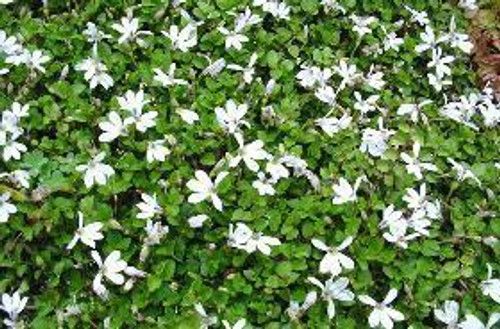Product Description
Pratia angulata
Common Name: White Star Creeper, Creeping Pratia, Fragrant Carpet
Zones 7 to 9, maybe hardy to zone 5 with winter protection.
Full sun to part shade.
Plants reach 1 to 2 inches tall;
creeping stems may spread indefinitely to form a ground cover mat.
Growth rate: Medium, however it can spread aggressively in ideal growing conditions.
Pratia angulata, also known as the White Star Creeper, is a vigorous and charming groundcover plant native to New Zealand. It's a fantastic option for adding a lush, green carpet to your garden, and it even tolerates some foot traffic. Here's a breakdown of its key features and how to grow it:
- Low-Growing Mat: Pratia angulata forms a dense mat of ground-hugging foliage, typically reaching only 1-2 inches tall. It spreads rapidly via creeping stems that root as they touch the soil, creating a lush, weed-suppressing carpet.
- Starry White Flowers: From spring to late summer, the plant is adorned with small, star-shaped white flowers with purple veins. These delicate blooms add a touch of charm and attract pollinators to the garden.
- Showy Berries: In fall, the flowers give way to spherical, red to purple berries that are surprisingly large and showy for such a small plant. These berries add another layer of interest and provide food for birds.
- Versatile Uses: Pratia angulata is incredibly versatile and can be used in various settings, including rock gardens, between stepping stones, as a lawn substitute for small areas, or even in containers and hanging baskets.
- Tolerates Foot Traffic: Unlike many delicate groundcovers, Pratia angulata can handle moderate foot traffic, making it suitable for pathways and areas where people may occasionally walk.
- Adaptable: It thrives in a variety of conditions, from full sun to partial shade, and tolerates different soil types as long as they are well-drained.
Growing Tips:
- Sunlight: Plant in full sun to partial shade. It prefers at least 4-6 hours of sunlight per day for optimal flowering.
- Soil: Prefers moist, well-drained soil. Amend heavy clay soil with compost or other organic matter to improve drainage.
- Water: Water regularly, especially during hot, dry periods, to keep the soil evenly moist.
- Hardiness: Pratia angulata is hardy in USDA zones 6-10, tolerating a wide range of temperatures.
- Maintenance: This groundcover is relatively low-maintenance. You can trim it back lightly if it starts to spread beyond its desired area.
Design Ideas:
- Between Stepping Stones: Pratia angulata softens the look of hardscaping and adds a touch of greenery to pathways.
- Lawn Substitute: For small areas with light foot traffic, it can be used as a low-maintenance alternative to grass.
- Rock Gardens: Its bright green foliage and white flowers create a beautiful contrast with rocks and other alpine plants.
- Containers: Use it as a "spiller" plant in containers to add a touch of vibrant color and texture.
- Underplanting: Plant it under trees and shrubs to create a lush, weed-suppressing groundcover.
Ten (10) plants in 4.5-inch containers per flat (or tray).
Other Details
The most important part of the plant is its root system. Healthy roots are the foundation of a healthy, vibrant plant. The type of plug container used is based on the specific needs of the plants. Perennials offered as bare root traditionally perform better when planted as bare root.Planted in a specialized mix, potted plants have well established root systems. Top growth stage will vary depending on the current life cycle and time of year when shipped. In Winter and early Spring dormant plants may be shipped. Dormant plants may be planted right away, even before the last frost date.
Most bare root varieties are field grown for at least one season, though Hemerocallis and Hosta are grown for two seasons. The bulk of the soil is removed during the harvesting process and the tops of most varieties are trimmed back to the crown. They are graded, packed in shredded aspen or sphagnum moss and stored in freezers until ready to be shipped.
See our Container Sizes and Bare Root Perennials pages for more information.
Plant information and care is provided in the Overview section, Plant Genus Page and general information is provided in the Planting Care & Guides. Additional questions can be asked on each Plant page.
Plant Spacing: Using the maximum mature spread or width of a plant to guide spacing, ensures space to grow to full size. To fill an area sooner, plant them closer together. Just remember, future thinning or transplanting may be needed.
Water: Keep a close eye on newly planted perennials, especially throughout the first growing year. Most early plant loss is due to too much or too little water!







